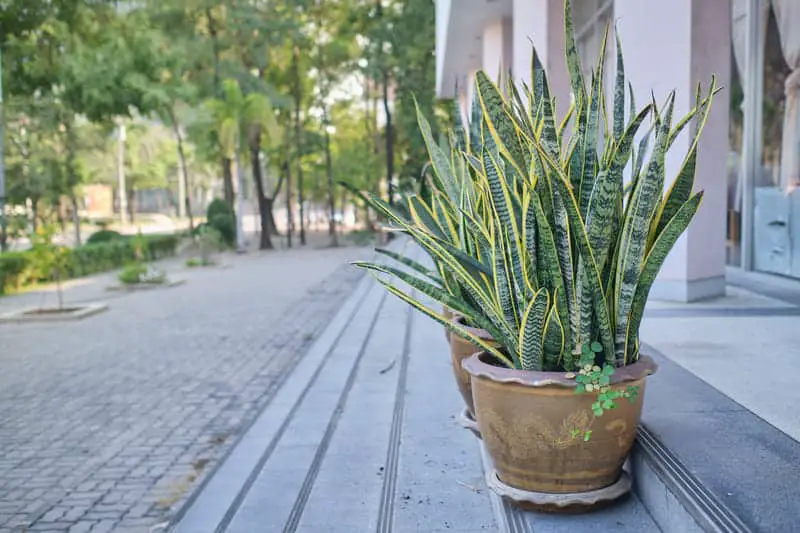Yes, snake plants can live outside, but they need to be in a shady spot that doesn’t get too much sun or wind. They also need well-draining soil and should be watered regularly. If you live in a cold climate, it’s best to bring your snake plant indoors for the winter.
If you’re thinking about adding a snake plant to your outdoor space, you might be wondering if these plants can live outside. The answer is yes! Snake plants are actually quite tolerant of both hot and cold weather, making them ideal for growing in a wide range of climates.
However, there are a few things to keep in mind if you want your snake plant to thrive outdoors. First, make sure that you choose a spot that gets plenty of bright light. Snake plants do best in full sun but can also tolerate partial shade.
If you live in an area with hot summers, it’s especially important to choose a spot that won’t get too much direct afternoon sun, as this can scorch the leaves. Secondly, be sure to water your snake plant regularly. These plants prefer soil that is always moist but not soggy, so aim for watering about once per week or as needed to keep the soil moist.
In particularly hot or dry weather, you may need to water more frequently. Finally, don’t forget to fertilize your snake plant every few months during the growing season. A good quality all-purpose fertilizer will work well for these plants.
With proper care, your snake plant will thrive and add interest to your outdoor space for many years to come!
Can Snake Plants Live Outside
What Temperature Can a Snake Plant Tolerate?
A snake plant, also known as mother-in-law’s tongue or sansevieria, is a tough and hardy plant that can tolerate a wide range of temperatures. It is native to Africa and Asia, and is commonly found in arid, dry climates. Snake plants are succulents, which means they store water in their leaves and stems.
This allows them to survive in conditions where other plants would quickly die from lack of water. The ideal temperature for a snake plant is between 65 and 75 degrees Fahrenheit (18-24 degrees Celsius). However, it can tolerate much hotter or cooler temperatures for short periods of time.
If the temperature drops below 50 degrees Fahrenheit (10 degrees Celsius), the leaves of the snake plant may start to turn brown and wilt. However, as long as the roots are not frozen, the plant will recover once the temperature rises again. In very cold weather, it is best to bring your snake plant indoors to protect it from frost damage.
Overall, snake plants are very tolerant of different temperatures and can thrive in a wide variety of environments.
Are Snake Plants Better Inside Or Outside?
There are many benefits to keeping a snake plant both inside and outside of your home. Snake plants are known to be very easy to care for, as they require very little water and can tolerate low light levels. They also help to purify the air, by absorbing toxins and releasing oxygen back into the room.
So, which is better? It really depends on your personal preferences and what you are looking for in a plant. If you want something that is easy to care for and doesn’t need much attention, then a snake plant is a great option.
If you are looking for a plant that will help purify the air in your home, then a snake plant is also a good choice. Ultimately, it comes down to what you value most in a plant.
How Do You Take Care of Outdoor Snake Plants?
When it comes to taking care of outdoor snake plants, there are a few things you need to keep in mind.
First and foremost, these plants prefer warm climates and will not do well in cold weather. If you live in an area with a colder climate, it’s best to bring your plant indoors during the winter months.
Secondly, snake plants are drought tolerant and don’t require a lot of water. In fact, too much water can actually be harmful to the plant. Allow the soil to dry out completely between watering sessions.
Lastly, make sure you provide plenty of drainage for your plant as they don’t like sitting in wet soil. Outdoor snake plants are relatively low-maintenance and can thrive with minimal care. Just remember to give them plenty of warmth and sunshine!

Can Snake Plants Survive Winter Outside?
Many people are wondering if their snake plants can survive winter outside. The answer is yes, but there are a few things you need to do to make sure your plant thrives.
First, choose a location that is protected from the wind.
Snake plants are native to Africa, so they are used to warm climates. If you live in an area where it gets cold in the winter, find a spot near your house or garage where the plant will be protected from the elements.
Second, water your snake plant regularly throughout the winter.
These plants like to stay moist, so be sure to check the soil frequently and water when necessary. In general, you should water about once a week or as needed.
Third, fertilize your snake plant during the growing season (spring and summer).
This will help it stay healthy and produce new growth. You can use any type of fertilizer, but organic options are always best. Look for products that contain nitrogen, phosphorus, and potassium – these nutrients are essential for healthy plant growth.
Finally, don’t forget to prune your snake plant periodically. Trimming back dead leaves and stems will promote new growth and keep your plant looking its best. If you live in an area with very harsh winters, it’s best to bring your snake plant inside during this time.
Otherwise, simply leave it outdoors and enjoy watching it prosper all season long!
Can Snake Plants Live Outside in Summer?
If you’re wondering whether snake plants can live outside in summer, the answer is yes! These hardy plants are native to Africa and thrive in hot, dry conditions. Snake plants are also known as mother-in-law’s tongue or sansevieria, and they make excellent houseplants or accent plants for your garden.
Snake plants are tolerant of a wide range of conditions, but they prefer bright light and well-drained soil. If you live in an area with high temperatures and low humidity, your snake plant will be just fine outdoors. However, if you live in a more temperate climate, it’s best to bring your snake plant indoors during the winter months.
If you’re looking for a tough plant that can tolerate neglect, a snake plant is a great choice. These interesting plants are virtually indestructible and will add a touch of drama to any space.
Can Snake Plants Live Outside in Florida?
If you’re looking for a low-maintenance, easy-to-care-for plant that can thrive both indoors and out, look no further than the snake plant. Also known as mother-in-law’s tongue or sanseveria, this hardy succulent is native to Africa and tolerates a wide range of growing conditions. So, if you’re wondering whether you can grow a snake plant outdoors in Florida, the answer is yes!
With its sword-like leaves and upright growth habit, the snake plant makes a striking addition to any landscape. And since it’s so tolerant of heat and humidity, it’s an ideal choice for Florida gardens. Snake plants prefer well-drained soil and full sun to partial shade, so choose a spot in your yard that gets plenty of sunlight.
Once established, they are quite drought tolerant and don’t need much water – in fact, too much water can be detrimental to their health. So be sure to let the soil dry out between watering sessions. If you live in an area with freezing temperatures in winter, you’ll need to bring your snake plants indoors before the first frost hits.
But other than that, there’s not much special care required to keep these tough plants happy and healthy. So if you’re looking for a hassle-free way to add some interest to your landscape (or indoor space), consider adding a few snake plants to your collection!
Conclusion
If you’re thinking about moving your snake plant outdoors, you’re in luck! These tough plants can withstand a wide range of conditions, making them perfect for both sunny and shady spots. Just make sure to acclimate them slowly to their new environment and protect them from frost.
With a little care, your snake plant will thrive in its new home.
